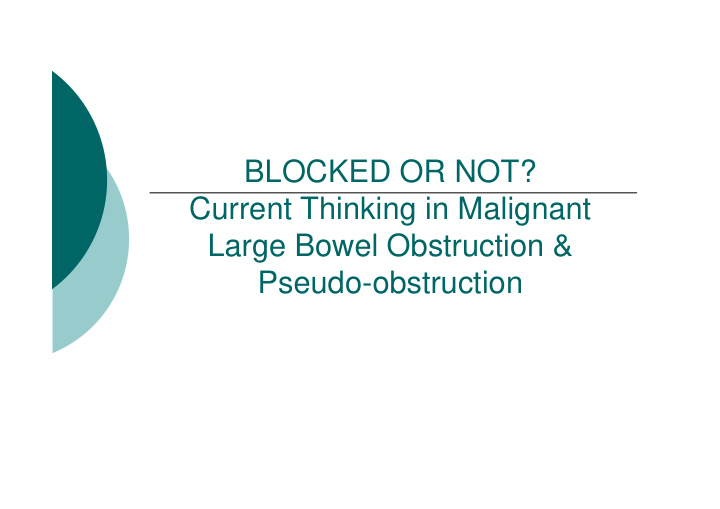



BLOCKED OR NOT? Current Thinking in Malignant Large Bowel Obstruction & Large Bowel Obstruction & Pseudo-obstruction
Aim To discuss the investigation and management of large bowel obstruction and pseudo�obstruction � ���������� � ���������� � To discuss the management of two patient case examples � Using these patient examples, discuss the investigation and management of large bowel obstruction and pseudo�obstruction � To summarise the evidence in the literature regarding these conditions
Case 1 46 year old man Apr ��� �������� : Change in bowel habit & weight loss, malnourished, skin and bones May May ������������� ������������� Complete obstruction to passage of barium in the distal sigmoid colon. Evidence of obstruction above with dilated air filled large bowel above. Cause of obstruction cannot be determined. May ������������������� Unwell, vomiting, abdo pain, diarrhoea PMH: NIDDM, appendicectomy What next…?
Case 1 - continued Expandable metallic stent Palliative Hartmann’s procedure (liver mets) Post�op chemotherapy In this case colonic stenting enabled:� � Immediate symptomatic relief � Pre�operative resuscitation and bowel preparation � Surgery to be performed electively
Case 2 80 year old man ������������ 15Feb Abdo distension, BNO 3 days, nausea & lethargy Not PU’ed for 24 hours PMH: Constipation, prostate cancer, CVA & left hemiparesis 11/05 DH: Aspirin, dipyridamole, simvastatin, zoladex DH: Aspirin, dipyridamole, simvastatin, zoladex O/E: HR 106 (atrial fibrillation) BP 128/73 RR 20 Sats 98% on air Bibasal creps Abdo distended, tympanic and non�tender ECG � AF, ST depression / T inversion V2�6, LBBB Bloods � Na 126, K 3.2, CRP 53.4, WCC 9.2
Rigid Σ 1000mls stool / liquid � 16Feb Flatus tube passed CT abdo � Dilated large bowel. Caecum 8.5cm Small bowel normal ?Sigmoid volvulus / tumour 17Feb CT findings � Pseudo�obstruction What next …?
Case 2 - continued Colonoscopy � Decompression Erythromycin Sando K 18Feb Flatus tube reinserted 18Feb Flatus tube reinserted 24Feb Transferred to Hospital for rehab
Malignant Large Bowel Obstruction � >50% aged >70yrs � Remember other causes: Volvulus / diverticula / stool � Presentation depends on � Presentation depends on site � Right: Vomiting and abdo pain start earlier � Left: Preceding change in bowel habit / PR bleeding
LBO - Investigation � Plain AXR � Water�soluble contrast enema
Water-soluble contrast enema Rectosigmoid lesion Splenic flexure lesion
LBO - Investigation � Plain AXR � Water�soluble contrast enema � ?Colonoscopy / sigmoidoscopy � CT scan (also identifies distal spread)
CT Scan
LBO - Management � Non�operative (pre�op adjuncts or definitive) � ����������� ��!"�#$��% Kiefhaber et al 1986 (57 patients), Eckhauser et al 1992 (29 patients) patients) � &���������������� �������� ������� Nozoe et al 2000 (5 patients), Tanaka et al 2001 (36 patients) � '( ������������������� Upto 60 yrs old obstruction with liver mets(bilateral) 60 and above with or without liver mets Malnoursihed / severe comorbidityComplications include stent migration, tumour ingrowth, perforation
Expandable metallic stent � ���#� ������ ������� � Enable systemic support and bowel preparation � May obviate need for faecal diversion or on table lavage diversion or on table lavage � ���������� � Eliminate need for urgent colostomy
Expandable metallic stents - Evidence � )���������������� ���������*+#,--. Mainar 1999, Saida 1996, Tejero 1997 � )��������������� ��������*-#,--. De Gregorio 1998, Mainar 1999, Saida 1996 De Gregorio 1998, Mainar 1999, Saida 1996 � /�� ����������,0#0�. Binkert 1998, De Gregorio 1998 � Perforation most common � Stent migration 5%, re�occlusion � Curative to palliative � 1����������� �������2,#,--.����3�������
LBO - Management � Operative � Right sided obstruction � Right hemicolectomy with primary anastomosis "��,-.����4�����5�,6.����������7�)�� ��������������7 "��,-.����4�����5�,6.����������7�)�� ��������������7 � Right hemicolectomy with exteriorisation of both ends � Ileo�transverse bypass � Transverse colon � Extended right hemicolectomy � Left sided obstruction � 3 stage vs. 2 stage vs. 1 stage
Acute Colonic Pseudo-obstruction 80% have underlying cause � Commonest conditions are � Metabolic � Trauma � Cardiorespiratory � About 200 deaths per annum � Aetiology: Altered autonomic � regulation of colonic motor function Symptoms & signs of LBO � 82% left sided �
ACPO - Investigation Plain AXR � "� Caecum >12cm or duration � >6 days = Risk of perforation Water�soluble contrast enema � Koruth et al 1985 91 patients had contrast enema � � 79 clinically LBO 50 obstructed � 29 no obstruction (11 colonic � pathology, 18 ACPO) � 12 clinically ACPO 2 had colonic cancer � CT scan �
ACPO - Management Non�operative � Supportive treatment � � Stop drugs affecting gut motility � Correct electrolyte abnormalities � NG tube / flatus tube Pharmacological � � Neostigmine (reversible Anti�cholinesterase inhibitor) � Neostigmine (reversible Anti�cholinesterase inhibitor) � Erythromycin (motilin receptor agonist) Armstrong et al 1991 – 500mg qds for 10 days �
Colonoscopic decompression � � Indicated where caecum>10cm or fail to settle 24�48 hours � Successful 73�90% of patients � BUT 15�29% recurrence � Risk of perforation 3%
ACPO - Management � Operative Indications � � Signs of colonic ischaemia or perforation � Failure of non�operative treatment � Caecal distension (9�12cm) � Continued caecal distension >48�72 hours � Continued caecal distension >48�72 hours Procedures � � Percutanoues or trephine caecostomy � Laparotomy +/� right hemicolectomy � Primary anastomosis vs. Ileostomy & mucous fistula 30% morbidity and 6% mortality (Vanek et al 1986)
American Society for Gastrointestinal Endoscopy 2002 Algorithm for acute colonic pseudo�obstruction
Conclusions � ALL patients with suspected large bowel obstruction ������������������������������� should undergo water�soluble contrast enema or CT to exclude pseudo�obstruction � Surgery for malignant LBO should be performed electively and after staging where feasible � The definitive management of pseudo�obstruction remains unclear
� ���������� � To discuss the management of two patient case examples � Using these patient examples, discuss � Using these patient examples, discuss the investigation and management of large bowel obstruction and pseudo� obstruction � To summarise the evidence in the literature regarding these conditions
Recommend
More recommend